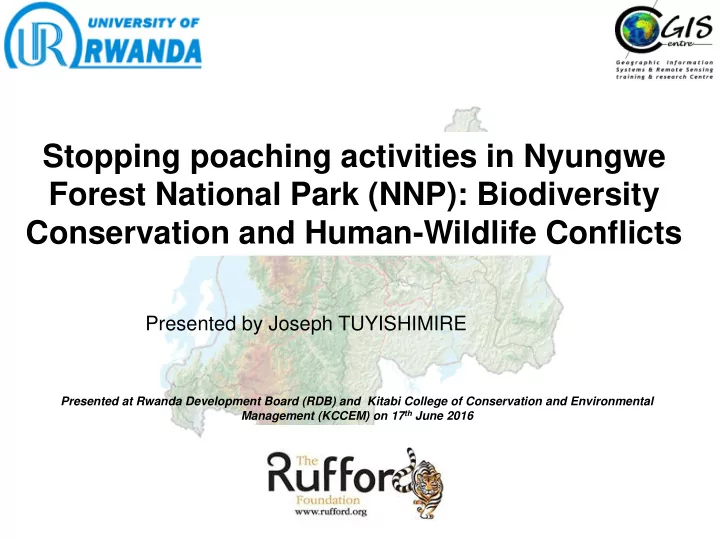

Stopping poaching activities in Nyungwe Forest National Park (NNP): Biodiversity Conservation and Human-Wildlife Conflicts Presented by Joseph TUYISHIMIRE Presented at Rwanda Development Board (RDB) and Kitabi College of Conservation and Environmental Management (KCCEM) on 17 th June 2016
Presentation outline • Background • Research aim and objectives • Methods • Findings and • Conclusion and way forward 17-06-2016 2
Background • Although NNP is protected, some illegal activities including animal poaching are still going on • The Park Managers are doing their best to stop these illegal activities • The halt of poaching activities should go together with the improvement of the livelihood of surrounding people • For the Park managers: A lot of achievements • For surrounding people: Insufficient alternate income generating activities!! Some of them are still relying on forest products • Law enforcement • Conflicts 17-06-2016 3
Aim and objectives Aim • To assess the balance between NNP animal diversity conservation and the improvement of the livelihood of surrounding people Objectives 1. Comparison between socio-economic situation of ex-poachers before and after stopping poaching activities in NNP 2. Assess the evolution of poaching activities over time 3. Identify methods of poaching in NNP 4. Identify causes of poaching 5. Identify target animals 17-06-2016 4
Methods I. Field work: Inside the forest To get sights of poaching activities: 9 sites: Bweyeye, Butare, Karengera, Cyato and Karambi of Nyamasheke District, Gatare and Kitabi of Nyamagabe District and Kivu of Nyaruguru District GPS coordinates were taken at the visited sites 17-06-2016 5
Methods I. Field work: Outside the forest For socio-economic data : The same sites (but outside the forest of course) were visited Questionnaires were GPS coordinates were taken. A total of 180 people were interviewed 17-06-2016 6
Methods II. RBM Dataset Data about poaching activities from August 2011 to July 2014 were obtained from Rwanda Development Board (RDB)/ Nature and Conservation Department in NNP. They consisted of the location and types of snares and target animals. Those data were collected opportunistically by NNP guards during their patrols and are stored in RDB database that is regularly updated. These data helped to map poaching activities over years (2011-2014) 17-06-2016 7
Findings 1.Socio-economic situation After poaching was prohibited, few of the respondents were still relying on poaching as a source of income, but agriculture became the major activity, followed by informal jobs, Livestock and beekeeping 17-06-2016 8
Findings 2. Evolution of poaching cases in NNP considerable decrease of poaching sights over years Kitabi site was characterized by the highest rate of poaching when only 2014 was considered, Rangiro was the highest 17-06-2016 9
Findings 3. Causes of poaching Site Cause Resistance to Search for Grand Habit Ignorance Poverty change meat Total Buruhukiro 0.00 22.73 0.00 9.09 4.55 100.00 Butare 5.00 55.00 40.00 0.00 0.00 100.00 Bweyeye 0.00 25.00 30.00 10.00 5.00 100.00 Karambi 8.70 34.78 56.52 0.00 0.00 100.00 Karengera 13.04 26.09 60.87 0.00 0.00 100.00 Kitabi 13.64 31.82 54.55 0.00 0.00 100.00 Kivu 3.85 30.77 65.38 0.00 0.00 100.00 Rangiro 4.76 57.14 38.10 0.00 0.00 100.00 Grand Total 6.21 35.03 44.07 2.26 1.13 100.00 17-06-2016 10
Findings Snares are the most used 4. Causes of poaching Dogs are used to spy as they could identify dangers before humans!! 17-06-2016 11
Findings 5. Target animals Grand Site Antelope Boar Duiker Giant rat Chimpanzee Monkey Porcupine Total Buruhukiro 0.00 22.73 72.73 0.00 0.00 0.00 4.55 100.00 Butare 0.00 10.00 85.00 0.00 0.00 0.00 5.00 100.00 Bweyeye 5.00 25.00 25.00 20.00 5.00 0.00 15.00 100.00 Karambi 4.35 17.39 43.48 17.39 4.35 0.00 13.04 100.00 Karengera 0.00 34.78 56.52 4.35 0.00 0.00 4.35 100.00 Kitabi 0.00 36.36 45.45 4.55 0.00 0.00 13.64 100.00 Kivu 0.00 15.38 53.85 3.85 0.00 7.69 15.38 100.00 Rangiro 0.00 19.05 76.19 0.00 0.00 0.00 4.76 100.00 Grand Total 1.13 22.60 57.06 6.21 1.13 1.13 9.60 100.00 17-06-2016 12
Conclusions and way forward • There is a decrease of poaching activities since they were declared illegal in NNP. • Ignorance and poverty are the main causes of poaching • The ban of poaching activities in NNP would not achieve its target unless other sources of revenue such as agriculture, livestock, handcraft, beekeeping and informal jobs are strengthened • Once food security is guaranteed, people in the study area should no more rely upon the forest products • The education of children at school age will raise awareness and help to block the transmission of poaching techniques and habits from parents to children. 17-06-2016 13
Acknowledgement • Rufford for the financial support of this research • RDB for the provision of RBM Dataset and the facilitation during our field work • University of Rwanda especially CGIS and CoEB for the support and daily collaboration 17-06-2016 14
17-06-2016 15
Recommend
More recommend